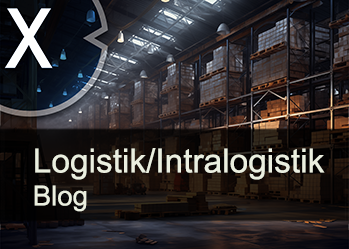Deep-water port JadeWeserPort: The container million record and its significance for Germany's port landscape
Xpert pre-release
Language selection 📢
Published on: October 8, 2025 / Updated on: October 8, 2025 – Author: Konrad Wolfenstein

Deepwater port JadeWeserPort: The container million-dollar record and its significance for Germany's port landscape – Creative image: Xpert.Digital
After 13 years of stagnation, a million-euro record has been broken: How two shipping giants are reviving the JadeWeserPort
Faster than ever from China: The trick with which Wilhelmshaven is revolutionizing logistics
Long considered the problem child of the German port landscape, JadeWeserPort in Wilhelmshaven is now making history. In September 2025, the magic mark of one million standard containers (TEU) handled within a year was broken for the first time – a milestone that marks a decisive turning point after 13 often arduous years of operation. The driving force behind this unprecedented success is the strategic alliance "Gemini Cooperation" between shipping giants Maersk and Hapag-Lloyd, which has been using Germany's only deep-water port as a central hub in its global network since the beginning of 2025. This breakthrough not only repositions Wilhelmshaven in the face of fierce competition from established ports such as Hamburg and Rotterdam, but also sets the course for the future of German logistics. The record is more than just a number: It symbolizes a strategic realignment that has the potential to shake up European maritime trade.
More than just a record: Why the success of the JadeWeserPort is important for all of Germany
The JadeWeserPort in Wilhelmshaven occupies a unique position in the German port landscape. As Germany's only deep-water port, its nautical characteristics distinguish it fundamentally from other German container ports. With a water depth of 18 meters at low tide, the world's largest container ships can be handled here, fully loaded and independent of the tide. This feature makes it a strategically important location that even the Port of Hamburg cannot offer due to its tidal restrictions.
The port area was created through complex sand dredging and covers a total area of 360 hectares. The container terminal itself extends over 130 hectares with a quay wall 1,725 meters long. The port was officially opened on September 21, 2012, after almost 20 years of planning and construction and was originally scheduled to reach full capacity within five years.
How was the million-dollar record achieved?
The historic moment occurred on September 18, 2025, when the millionth standard container of the year was handled at the EUROGATE Container Terminal Wilhelmshaven. This achievement marks a significant turning point in the port's history, which had never previously reached this milestone in its 13 years of operation. The anniversary container originated in China and contained machine parts for the international agricultural industry.
The comparison with previous years is particularly significant: 843,000 standard containers were handled throughout 2024, while the million mark had already been exceeded by September 2025. This development represents growth of more than 18 percent compared to the previous year, significantly exceeding the port operators' original expectations.
What role does the Gemini Cooperation play?
The key factor behind this extraordinary growth is the Gemini Cooperation, a strategic alliance between the two container shipping companies Hapag-Lloyd and Maersk, which began operations in February 2025. This cooperation pursues a hub-and-spoke system, with JadeWeserPort serving as one of the main transshipment points. The network comprises 57 services with a total capacity of 3.7 million TEU on approximately 340 vessels.
The alliance promises schedule reliability of over 90 percent, which is significantly higher than the industry average of around 50 percent. Gemini Cooperation was able to achieve this reliability rate in its first few months of operation, setting new standards in container logistics. For customers, this means more predictable supply chains and shorter transit times.
How does the hub-and-spoke system at JadeWeserPort work?
The Gemini Cooperation's hub-and-spoke system uses Wilhelmshaven as a central hub for various trades. The port is served by two major liner services: the NE1 service between Europe and Asia and the AL1 service between Northern Europe and North America. These main lines are complemented by a network of 28 shuttle services connecting smaller ports.
A special feature is that Wilhelmshaven is the first European port on the direct connection between Europe and Asia. This position offers logistical advantages for customers who want to transport their goods quickly to the European hinterland. The system also allows for the use of larger ships on the main routes, which brings both economic and ecological benefits.
What does this development mean for German port competition?
The success of JadeWeserPort fits into a complex competitive landscape among German North Sea ports. Hamburg remains Germany's largest seaport with approximately 97 million tons of cargo throughput, followed by Bremerhaven with 42.5 million tons. Wilhelmshaven ranks third with 34.5 million tons, although container throughput accounts for only a portion of total throughput.
The German port landscape is part of the so-called North Range, which also includes the major Dutch and Belgian ports of Rotterdam and Antwerp. These ports compete for the same cargo flows, especially in the lucrative Asia-Europe trade. JadeWeserPort has struggled to establish itself in this competition, but the Gemini Cooperation now appears to be bringing the expected breakthrough.
What technical features make the JadeWeserPort attractive?
The technical equipment at JadeWeserPort is designed to meet the requirements of modern large container ships. Eight post-Panamax container gantry cranes, each weighing 1,750 tons and 83 meters high, can handle containers weighing up to 120 tons. The 69-meter-long booms allow for the handling of ships up to 430 meters long and with a capacity of over 18,000 TEU.
This infrastructure has been continuously modernized in recent years. Eurogate invested in raising its container gantry cranes by 11 meters each to accommodate even larger ships. In addition, work is underway on further automation solutions designed to increase the efficiency of terminal operations. These measures are expected to increase the theoretical capacity to as much as 4.2 million TEU.
How is the hinterland connection developing?
A crucial success factor for any container port is the quality of its hinterland connections. JadeWeserPort has a direct connection to the A29 federal highway, which leads directly to the port grounds without traffic lights. This connection enables smooth truck transport in all directions of the German and European road network.
Equally important is the rail connection via a 16-track depot with a direct connection to the Deutsche Bahn network. The adjacent freight transport center, covering an area of 160 hectares, offers ideal location opportunities for logistics companies and allows for the option of rail sidings. This multimodal connection is crucial for the onward distribution of containers to the European hinterland.
Your container high-bay warehouse and container terminal experts

Container terminal systems for road, rail, and sea in the dual-use logistics concept of heavy-duty logistics - Creative image: Xpert.Digital
In a world characterized by geopolitical upheavals, fragile supply chains, and a new awareness of the vulnerability of critical infrastructure, the concept of national security is undergoing a fundamental reassessment. A state's ability to ensure its economic prosperity, the supply of its population, and its military capability increasingly depends on the resilience of its logistics networks. In this context, the term "dual-use" is evolving from a niche category of export control to a overarching strategic doctrine. This shift is not merely a technical adaptation, but a necessary response to the "turning point" that requires the profound integration of civilian and military capabilities.
Suitable for:
Direct to China in 25 days: Automation, LNG and expansion plans – How Wilhelmshaven aims to become a logistics center
What role do international trade routes play?
JadeWeserPort benefits from its position on key international trade routes. Container traffic between Asia and Europe is one of the most important global trade routes, and the Gemini Cooperation has established the port as a central hub for this route. The NE1 service connects Wilhelmshaven with important Chinese ports such as Shanghai and Ningbo, as well as with other European ports.
Particularly noteworthy is a new direct connection to China, operated by the Chinese shipping company KAWA Shipping. This connection shortens the transit time between Ningbo and Wilhelmshaven to just 25 days, compared to the usual 30 to 40 days for connections with stopovers. Such direct connections strengthen the position of JadeWeserPort as an efficient logistics hub.
How does the success affect the regional economy?
The growing success of JadeWeserPort has a positive impact on the entire region. Companies like Gebrüder Weiss use the port as a central transshipment point for their European logistics networks. From Wilhelmshaven, the Austrian logistics company organizes the onward transport of overseas goods by rail to Germany and Austria.
The direct connection to the Far East and fast processing make the location attractive for international companies. The high availability of goods thanks to the improved schedule reliability of the Gemini Cooperation further contributes to the location's attractiveness. This creates jobs in the region and strengthens Wilhelmshaven as a logistics hub.
What challenges remain?
Despite reaching this milestone, JadeWeserPort is still far from reaching full capacity. The theoretical capacity is 2.7 million TEU per year, meaning that even with one million containers handled, only approximately 37 percent of the available capacity is being utilized. This underutilization continues to pose an economic challenge for the operators.
Competition from established ports such as Hamburg and Rotterdam remains. Hamburg recorded 6.3 percent growth in container throughput in the first quarter of 2025, reaching 2.0 million TEU. Competitors in the Netherlands and Belgium are also continuously investing in their infrastructure and expanding their capacities. JadeWeserPort must therefore further expand its competitive advantages and attract new customers.
How are European container traffic developing?
The European container market is subject to constant change due to geopolitical developments and economic trends. Trade between Europe and Asia is growing continuously, with imports from China playing a particularly important role. At the same time, trade conflicts and geopolitical tensions are leading to shifts in trade flows.
One example of innovative solutions is the development of the Northern Sea Route through the Arctic, which is being tested by some shipping companies as an alternative connection between Asia and Europe. This route could reduce transit times from 30-50 days to just 18 days, but due to climatic conditions, it is only available seasonally. Such developments demonstrate the dynamic development of international container traffic.
What are the future prospects for JadeWeserPort?
Port operators are optimistic about future developments. Holger Banik of NPorts forecast throughput of between 1.3 and 1.5 million TEU for 2025 at the beginning of the year. This forecast seems realistic, as the one-million-tonne mark was already reached in September. In the long term, there are even discussions about expanding the port.
Through further automation and possible infrastructure expansions, capacity could be increased to up to 4.2 million TEU. In addition to container handling, the port is also developing in other areas: automotive handling was doubled to more than 74,000 vehicles in 2024, and new terminals for liquefied natural gas are being built as part of the energy transition.
What does the record mean for the German logistics industry?
The success of JadeWeserPort is a positive signal for the German logistics industry, which is under pressure from international competition. The port demonstrates that even new locations can be successful if they enter into the right strategic partnerships and leverage their technological advantages. The collaboration with Gemini Cooperation demonstrates how important it is for ports to integrate into global logistics networks.
The improved schedule reliability and direct connections to Asia strengthen Germany's position in international trade. For companies, this means more stable supply chains and more predictable logistics costs. This success could also motivate other German ports to rethink their strategies and seek new partnerships.
How does digitalization affect port operations?
Modern container terminals are increasingly relying on digital technologies to optimize their processes. JadeWeserPort is continuously investing in automation solutions designed to increase efficiency and reduce costs. These technologies include automated container gantry cranes, intelligent transport systems, and digital planning tools.
Gemini Cooperation also uses modern IT systems to coordinate its global fleet and ensure high schedule reliability. Digitalization enables shipping companies and port operators to better coordinate their operations and provide customers with more transparent information about the status of their shipments. This contributes to the overall efficiency of the logistics system.
Which ecological aspects play a role?
Sustainability is becoming increasingly important in container shipping. Gemini Corporation is also promoting its hub-and-spoke system as a more environmentally friendly alternative to traditional routing strategies. By using larger ships on the main routes and optimizing speeds, fuel consumption and emissions can be reduced.
JadeWeserPort's location contributes to reducing emissions, as the short transit distance of just 23 nautical miles minimizes fuel consumption. Furthermore, the port is increasingly integrated into the energy transition, with plans for LNG terminals and other alternative energy sources. These developments position the port as a sustainable logistics location.
A turning point for Germany's youngest deep-water port
The record of one million containers handled marks a significant turning point in the history of JadeWeserPort. After 13 years of operation, the port has finally achieved the anticipated breakthrough through its strategic partnership with Gemini Cooperation. The combination of technical advantages, strategic location, and operational excellence demonstrates the potential of Germany's only deep-water port.
Although considerable capacity reserves still exist, current developments indicate that JadeWeserPort has found its place in the German and European port landscape. Successful integration into global logistics networks and continuous investment in modern technologies lay the foundation for further growth. For the German economy, this means additional powerful access to global markets and a strengthened competitiveness in international trade.
Advice - planning - implementation
I would be happy to serve as your personal advisor.
Head of Business Development
Advice - planning - implementation
I would be happy to serve as your personal advisor.
contact me under Wolfenstein ∂ Xpert.digital
call me under +49 89 674 804 (Munich)
Our global industry and economic expertise in business development, sales and marketing

Our global industry and business expertise in business development, sales and marketing - Image: Xpert.Digital
Industry focus: B2B, digitalization (from AI to XR), mechanical engineering, logistics, renewable energies and industry
More about it here:
A topic hub with insights and expertise:
- Knowledge platform on the global and regional economy, innovation and industry-specific trends
- Collection of analyses, impulses and background information from our focus areas
- A place for expertise and information on current developments in business and technology
- Topic hub for companies that want to learn about markets, digitalization and industry innovations























